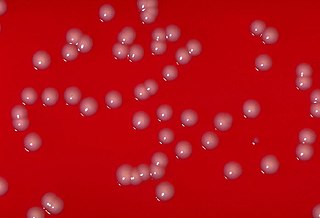Acetomicrobium is a genus in the phylum Synergistota (Bacteria). In 2016, the former genus Anaerobaculum was folded into Acetomicrobium.
Acidaminococcus is a genus in the phylum Bacillota (Bacteria), whose members are anaerobic diplococci that can use amino acids as the sole energy source for growth. Like other members of the class Negativicutes, they are gram-negative, despite being Bacillota, which are normally gram-positive.
Acrocarpospora is a genus of bacteria in the phylum Actinomycetota. The major respiratory quinone is menaquinone MK-9(H ) and use madurose, an actinomycete whole-cell sugar.
Actinoallomurus is a genus in the phylum Actinomycetota (Bacteria).
Actinocatenispora is a genus in the phylum Actinomycetota (Bacteria).
Actinopolymorpha is a genus in the phylum Actinomycetota (Bacteria).
Actinospica is a genus in the phylum Actinomycetota (Bacteria).
Deferribacter is a genus in the phylum Deferribacterota (Bacteria).
Dehalogenimonas is a genus in the phylum Chloroflexota (Bacteria). Members of the genus Dehalogenimonas can be referred to as dehalogenimonads.
Akkermansia is a genus in the phylum Verrucomicrobiota (Bacteria). The genus was first proposed by Derrien et al. (2004), with the type species Akkermansia muciniphila.
Cryptosporangium is a genus of bacteria in the phylum Actinomycetota.
Stigmatella is a bacterium genus in the phylum Myxococcota.
The Selenomonadales are an order of bacteria within the class Negativicutes; unlike most other members of Bacillota, they are Gram-negative. The phylogeny of this order was initially determined by 16S rRNA comparisons. More recently, molecular markers in the form of conserved signature indels (CSIs) have been found specific for all Selenomonadales species. On the basis of these markers, the Selenomonadales are inclusive of two distinct families, and are no longer the sole order within the Negativicutes. Several CSIs have also been found specific for both families, Sporomusaceae and Selenomonadceae. Samples of bacterial strains within this order have been isolated from the root canals of healthy human teeth.
The Nautiliaceae are a family of bacteria placed in an order to itself, Nautiliales. The members of the family are all thermophilic.
Microbispora is a Gram-positive, mesophilic, thermophilic and non-motile bacterial genus from the family of Streptosporangiaceae.
Acidicapsa is a bacterial genus from the family of Acidobacteriaceae.
Mucispirillum is a genus in the phylum Deferribacterota (Bacteria). It is represented by the single species Mucispirillum schaedleri|. It has been found in the intestinal tract of some rodents and considered a commensal with some association to disease. This species has been found in cockroaches mice, turkeys, dogs, pigs, goats, termites, and sometimes humans. It is anaerobic and does not form spores. It is motile, flagellated and thought to have the ability to move through mucus.
Marinactinospora is a genus in the phylum Actinomycetota (Bacteria). It contains a single species, Marinactinospora thermotolerans. The species has a high tolerance for environmental temperatures, up to 55°C.
Rubripirellula is a genus of bacteria from the family of Planctomycetaceae with five known species. Rubripirellula obstinata has been isolated from the alga Laminaria from the northern coast from Porto in Portugal.

The Mycobacteriales are an order of bacteria. The current description is genome-based, per Gupta 2019 emendation. Most members produce mycolic acids.
